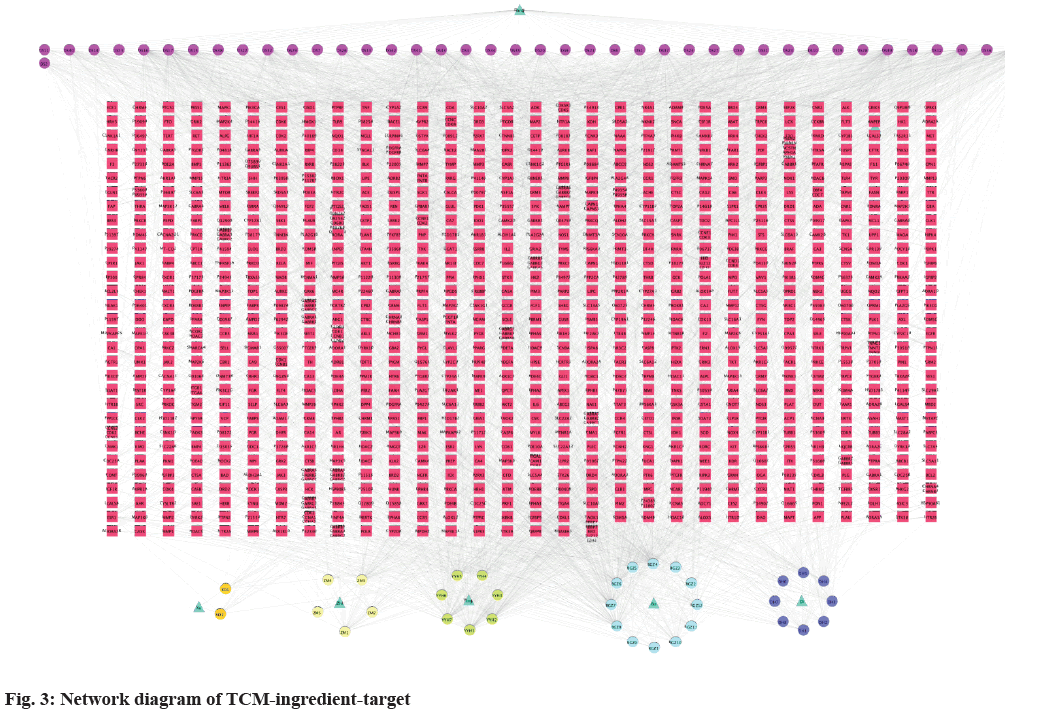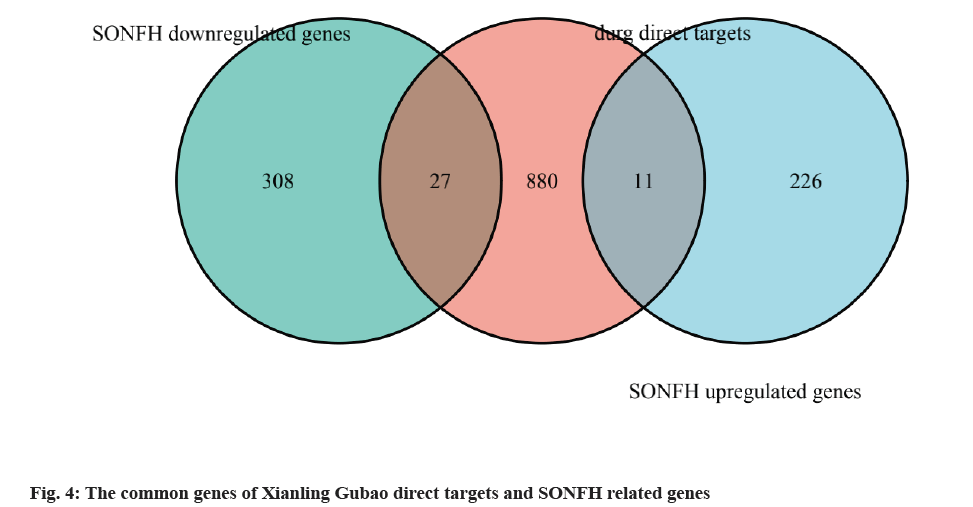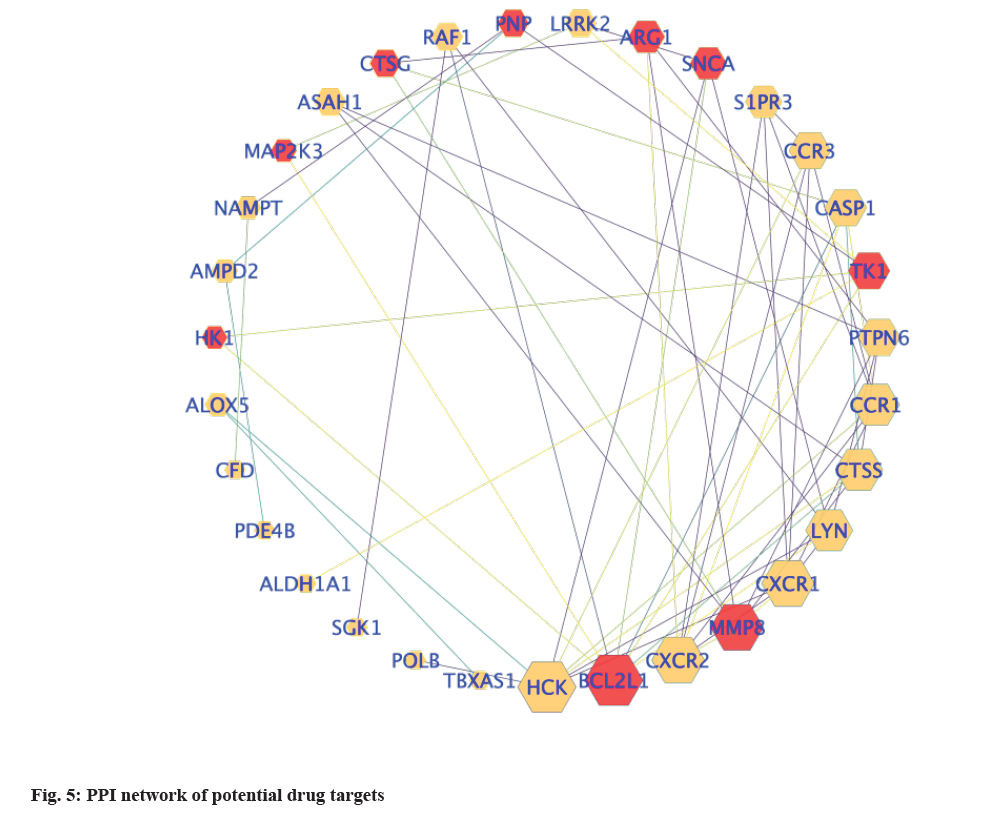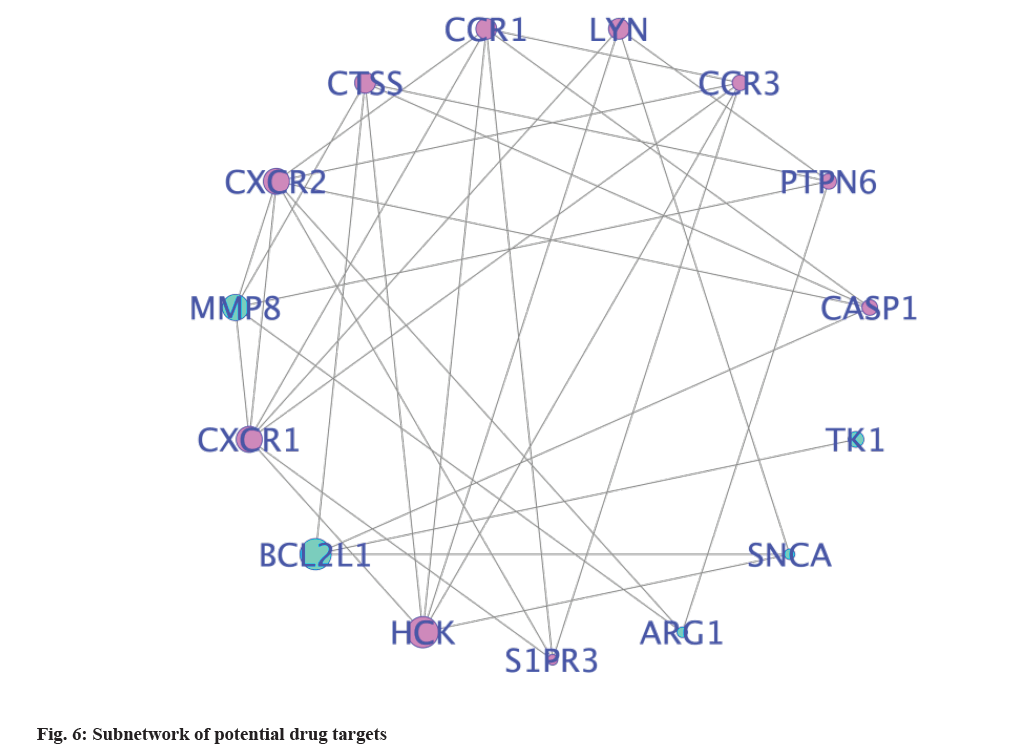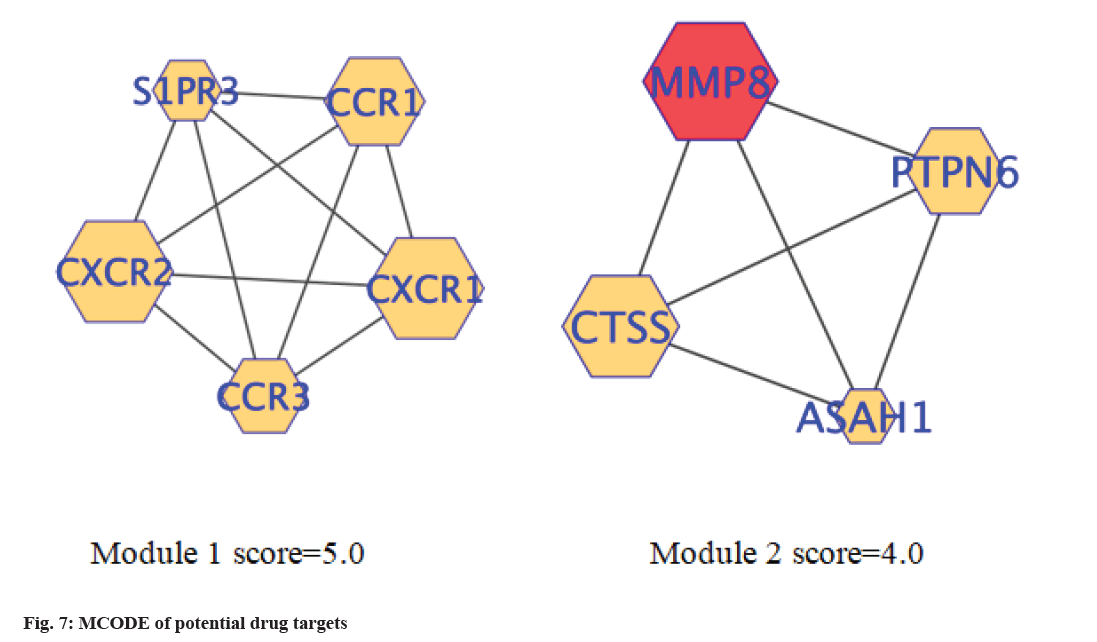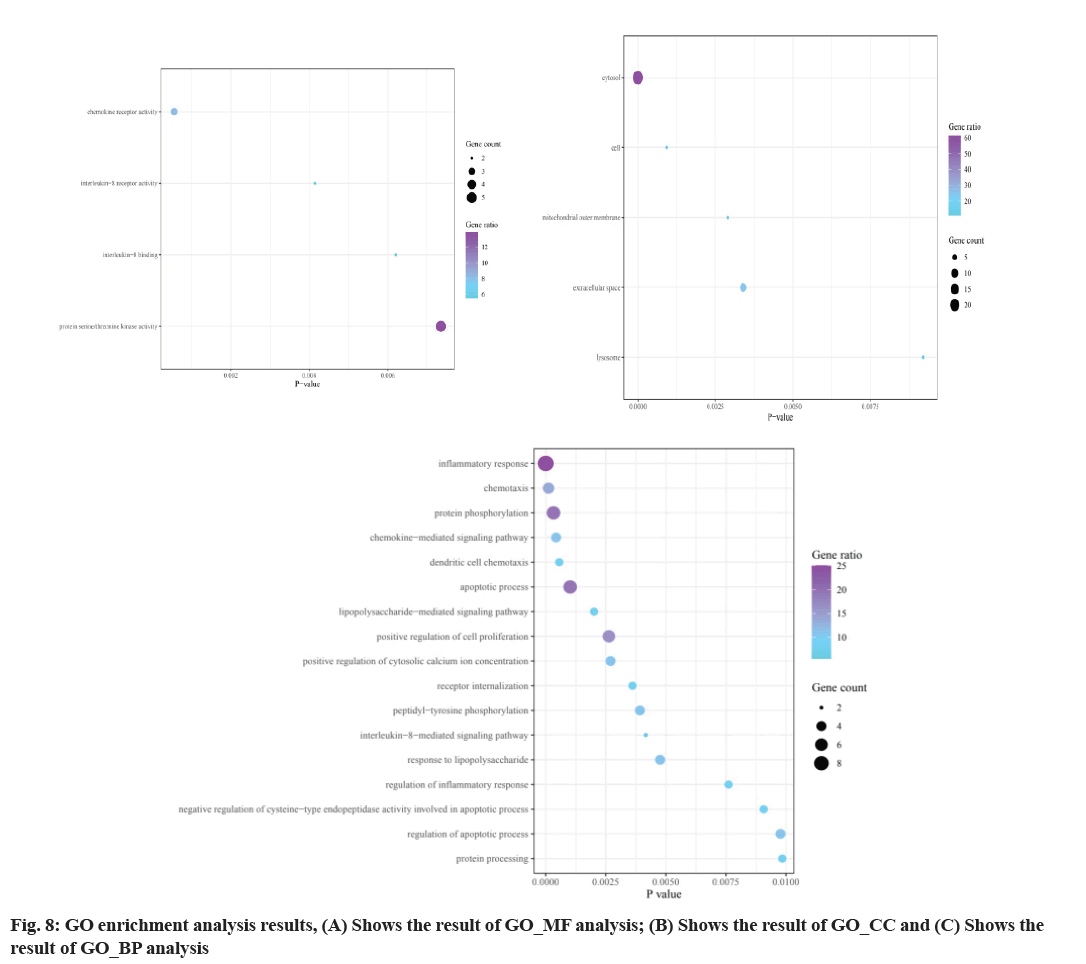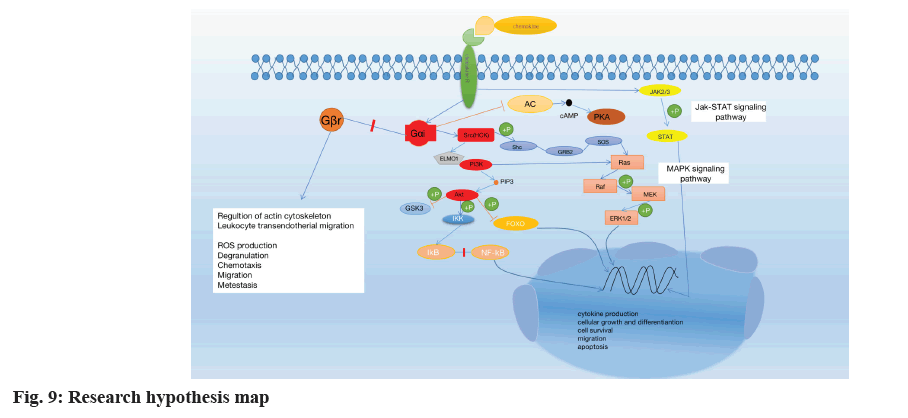- *Corresponding Author:
- S. Y. Lei
Department of Joint and Motor Surgery, The Second Affiliated Hospital of the University of South China, Hengyang, Hunan 421001, China
E-mail: leisaiyunqu@163.com
| This article was originally published in a special issue, “Modern Applications in Biomedical Research and Pharmaceutical Sciences” |
| Indian J Pharm Sci 2022:84(3) Spl Issue “253-266” |
This is an open access article distributed under the terms of the Creative Commons Attribution-NonCommercial-ShareAlike 3.0 License, which allows others to remix, tweak, and build upon the work non-commercially, as long as the author is credited and the new creations are licensed under the identical terms
Abstract
This study aimed to obtain the main active components of Xianling Gubao capsule and identify their pharmacological characteristics and mechanism of action in treatment of steroid-induced femoral head necrosis. The chemical constituents and direct targets of Xianling Gubao capsule were obtained by the system pharmacology platform of traditional Chinese medicine. GeneCards database and gene expression omnibus database were used to obtain pathogenic genes related to steroid-induced femoral head necrosis. Through Venn diagram software, the intersection of direct drug targets and disease-related genes was obtained to obtain the potential drug targets of Xianling Gubao capsule. In the Cytoscape 3.7.1 software, the drug component-target and protein-protein interaction networks were visualized and analyzed by network analyze plugin and molecular complex detection plugin, the degree values of nodes were analyzed to screen the core genes. Finally, the database for annotation, visualization and integrated discovery database was used for gene enrichment analysis. We obtained 76 chemical components of Xianling Gubao, 583 pathogenic related genes of steroid-induced femoral head necrosis and 38 potential drug targets of Xianling Gubao capsule for the treatment of steroid-induced femoral head necrosis. A drug componenttargets network with 1001 nodes and 3661 edges, a protein-protein interaction network with 31 nodes and 67 edges were constructed. 15 core genes were obtained by network topology analysis and enrichment analysis of potential drug targets showed that they were mainly concentrated in chemokine signaling pathway. Finally, 5 optimal drug targets of Xianling Gubao capsule for steroid-induced femoral head necrosis were obtained, respectively. Xianling Gubao capsule can prevent or treat steroid-induced femoral head necrosis by promoting the reconstruction of new capillaries after necrosis, improving intravascular coagulation, accelerating the formation of callus and regulating the differentiation and direction of bone marrow stem cells.
Keywords
Xianling Gubao capsule, steroid-induced necrosis of femoral head, chemokine receptor, network pharmacology
Steroid-Induced Femoral Head Necrosis (SONFH) is a special style of femoral head aseptic necrosis. It is due to the excessive accumulation of glucocorticoids in the body due to the large amount of glucocorticoids which leads to pathological changes such as lipid metabolism disorder, increased blood viscosity, microthrombosis and abnormal osteogenic differentiation of bone marrow stem cells in the body, and finally leads to necrosis of the femoral head[1]. Most of the patients had early atypical clinical symptoms, showing only pain after hip joint fatigue. Most SONFH patients have already progressed to stage III-IV by the time they come to the clinic due to their lack of awareness of the disease[2]. Therefore, early prevention of the disease is very important.
Xianling Gubao capsule contains six kinds of Chinese Traditional medicine, including Yin Yang Huo, Bu Gu Zhi, Xu Duan, Danshen, Zhimu, Dihuang. It has the effect of nourishing liver and kidney, activating blood circulation and degrading collaterals, and strengthening tendons and bones[3]. Mainly used in the treatment of osteoporosis, fracture, osteoarthritis and bone aseptic necrosis and other disease.
This study intends to analyze the main target and mechanism of Xianling Gubao capsule in the treatment of SONFH through network pharmacology and bioinformatics and to explore the clinical application value of Xianling Gubao capsule as a preventive drug for patients using a large number of glucocorticoids to alleviate or block the pathogenesis of SONFH.
Materials and Methods
Screening of effective chemical compositions of Xianling Gubao capsule:
The Chinese traditional medicine contained in Xianling Gubao capsule was obtained by literature retrieval. In the search box of Traditional Chinese Medicine (TCM) and chemical components in the chemical database, the names of six Chinese traditional medicines were respectively entered to obtain the corresponding chemical composition, molecular formula and Simplified Molecular Input Line Entry System (SMILES) ID. SMILES ID of chemical components were input into Swiss Absorption, Distribution, Metabolism and Excretion (ADME) database, through the screening of oral bioavailability and drug similarity, the effective chemical components of Xianling Gubao capsule were obtained.
To predict the direct target protein of Xianling Gubao capsule:
We input the above SMILES ID of Xianling Gubao capsule effective chemical composition into SwissTargetPrediction database and obtained its corresponding component target database file. Finally, the target protein of Xianling Gubao capsule was obtained.
Construction of Chinese traditional materialscomponent- target network:
Firstly, according to the above search results, the TCM component target network file and attribute file are constructed in Excel software. Secondly, the TCMcomponent- target network is obtained by importing the network file and properties file into Cytoscape 3.7.1 software. Finally, the properties box is adjusted to beautify the network.
Screening the genes related to SONFH:
Enter the keywords “SONFH” or “Steroid-induced femoral head necrosis” into the search box of Gene Expression Omnibus (GEO) database and download the series of matrix data and chip platform data.
Differential expression analysis was performed on the data by Excel software. According to p<0.05 and |log2FC|>1, screening of SONFH and non-SONFH differentially expressed genes as SONFH pathologic genes, in which log2FC>0 indicated that the gene was upregulated in SONFH and log2FC<0 indicated that the gene was downregulated in SONFH. Sangerbox mapping software was used to draw the differentially expressed genes heatmap and volcano map.
Construction of Protein-Protein Interaction (PPI) network:
First of all, we use Venn diagram to analyze the differentially-expressed genes of SONFH and direct target protein of Xianling Gubao capsule, and obtain the potential drug targets of Xianling Gubao capsule in the treatment of SONFH. Secondly, the relationship between potential drug targets was analyzed in Search Tool for the Retrieval of Interacting Genes/Proteins (STRING) database, and the “node to node” network file was downloaded. Then, the “node to node” relationship was analyzed in Excel software and the degree value of each node was obtained. Finally, we import the “node to node” network file and “node degree” properties file into the Cytoscape 3.7.1 software, and construct PPI network. We further obtained the core genes and modules by network analyze tool and Molecular Complex Detection (MCODE) plugin.
Gene enrichment analysis:
The Database for Annotation, Visualization and Integrated Discovery (DAVID) is the effective software for us to analyze the gene function and signaling pathway. Firstly, we enter the potential drug targets into “enter gene list” search box. Then, we import Homo sapiens into the “select species” search box. Finally, we choose “official_gene_symbol” choice and “gene list” choice. The Gene Ontology (GO) and Kyoto Encyclopedia of Genes and Genomes (KEGG) enrichment results were obtained. We further screened the Biological Process (BP), Molecular Function (MF), Cellular Component (CC) and signaling pathway with p<0.01 in Excel software.
Key targets and pharmacological mechanism of Xianling Gubao capsule in the treatment of SONFH:
The core genes in the PPI network and the genes enriched in the signaling pathway were analyzed by Venn diagram software and the key targets and biological effects were analyzed by KEGG mapper. Finally, the key target and the main mechanism of the drug were obtained.
Results and Discussion
The effective ingredients and direct targets of Xianling Gubao capsule were discussed below. Six kinds of Chinese Traditional medicine, Yin Yang Huo, Bu Gu Zhi, Xu Duan, Danshen, Zhimu, Dihuang were input into the retrieval box of chemical database and their corresponding molecular formula of chemical components and SMILES ID were obtained. In Swiss ADME, 76 active ingredients were obtained, including 42 active ingredients in Danshen, 8 in Dihuang, 7 in Yin Yang Huo, 12 in Bu Gu Zhi, 2 in Xu Duan and 5 in Zhimu.
In SwissTargetPrediction, we import SMILES ID of effective ingredients into search box and obtained the direct targets of each ingredient. After removing repeated targets and targets with probability=0.918 direct targets were finally obtained.
The gene microarray Genomic Spatial Event (GSE) 123 568 was obtained from the GEO database, containing 40 samples (10 non-SONFH samples and 30 SONFH samples), and came from GPL15207 ([PrimeView] Affymetrix Human Gene Expression Array) platform. We downloaded the series of matrix file and gene probe file, and proposed the data in Excel software (including substitution gene name, get rid of duplicate genes, data standardization). In accordance with condition of p<0.05 and |log2FC|>1, 583 differentially expressed genes were obtained, among then, 335 upregulated genes and 238 down regulated genes were obtained.
In Sangerbox software, we imported the differentiallyexpressed genes file, and the heatmap and volcano figure were constructed. The results are shown in fig. 1 and fig. 2.
In the grouping, red represents non-SONFH samples, blue represents SONFH samples; log2FC>0 represents non-SONFH up-regulated gene relative to SONFH, log2FC<0 represents non-SONFH down-regulated gene relative to SONFH; 238 non-SONFH differentially up-regulated genes and 335 non-SONFH differentially down-regulated genes are expressed in fig. 1.
The “node to node” network file and node attribute file were established among Chinese traditional medicine, drug ingredient and drug target, and the above files were input in the Cytoscape software to obtain a network diagram of Chinese traditional medicine-ingredienttarget. In the style attribute box, the nodes and edges can be set. In the layout, the drug targets can be set to “Grid Layout”, the drug ingredient corresponding to same Chinese traditional medicine can be set to “Attribute Circle Layout”. The network diagram of Chinese traditional medicine-ingredient-target is shown in fig. 3.
In fig. 3, square icon represents the direct targets of drugs; circular icon represents the chemical components corresponding to different Chinese herbal medicines; peach red, orange, yellow, green, blue and purple are used to represent the chemical components of Salvia miltiorrhiza, sequestration, Anemarrhena, Epimedium, Psoralea and Rehmannia respectively.
The direct targets of Xianling Gubao capsule and genes related to SONFH were analyzed by Venn diagram software, a total of 38 potential drug targets (27 upregulated and 11 downregulated) were obtained, the results are shown in fig. 4 where green represents differentially down-regulated genes in SONFH; blue represents differentially up-regulated genes in SONFH and red represents the direct targets of Xianling Gubao capsule.
We input above potential drug targets in STRING database, analyzed the interaction between potential drug targets and downloaded the “node to node” network file. In Excel software, we can analyze and obtain the “degree value” attribute file.
The “node to node” network file and “degree value” attribute file were imported into Cytoscape 3.7.1 software, and the PPI network was constructed. The result is shown in fig. 5, where the size of the icon represents the degree value of potential drug targets. The red icon represents up-regulated genes and the blue icon represents down-regulated genes. The edges color represents the combine score; the darker the color, the greater the value of combine score.
The targets of degree value>mean degree value were screened out and 15 core genes (HCK Proto-Oncogene, Src Family Tyrosine Kinase (HCK), B-cell lymphoma 2-like protein 1 (BCL2L1), C-X-C Motif Chemokine Receptor 2 (CXCR2), Matrix Metallopeptidase 8 (MMP8), C-X-C Motif Chemokine Receptor 1 (CXCR1), LYN Proto-Oncogene, Src Family Tyrosine Kinase (LYN), Cathepsin S (CTSS), C-C Motif Chemokine Receptor 1 (CCR1), Protein Tyrosine Phosphatase Non-Receptor Type 6 (PTPN6), Thymidine Kinase 1 (TK1), Caspase 1 (CASP1), C-C Motif Chemokine Receptor 3 (CCR3), Sphingosine- 1-Phosphate Receptor 3 (S1PR3), Synuclein Alpha (SNCA), Arginase 1 (ARG1)) were obtained, which were used to construct sub network. The results are shown in fig. 6 where 15 potential drug targets with degree greater than the average value were extracted from PPI network diagram to construct subnetwork; icon size represents the degree value of potential drug targets; red icon represents down-regulated genes and green icon represents up-regulated genes. In the MCODE plugin, we can obtain 2 modules, which are shown in fig. 7 where icon size represents the degree value. The red icon represents up-regulated genes and the blue icon represents down-regulated genes.
We can analyze the potential drug targets in the DAVID database. The GO enrichment analysis results contain GO_BP, GO_CC and GO_MF. GO_BP is mainly enriched in inflammatory response, protein phosphorylation, chemotaxis, positive regulation of cell proliferation and chemokine-mediated signaling pathway. GO_CC is enriched in “cytosol”, “mitochondrial outer membrane”, “extracellular space”, “cell” and “lysosome”. GO_MF is enriched in “chemokine receptor activity”, “protein serine/ threonine kinase activity”, “Adenosine Triphosphate (ATP) binding”, “interleukin-8 receptor activity” and “interleukin-8 binding”. The KEGG signaling pathway enrichment analysis results is mainly enriched in “chemokine signaling pathway” and the genes enriched in this signaling pathway are LYN, CCR1, CCR3, CXCR2, CXCR1, Raf-1 Proto-Oncogene, Serine/Threonine Kinase (RAF1). The results of GO and KEGG enrichment analysis bubble chart are shown in fig. 8 and Table 1.
| Category | Description | Gene count | Gene ratio | p value | Genes |
|---|---|---|---|---|---|
| GO _BP | Inflammatory response | 9 | 25 | 8.64E-07 | LYN, CCR1, POLB, HCK, CXCR1, CXCR2, PTAFR, S1PR3, CCR3 |
| Chemotaxis | 5 | 13.8889 | 1.17E-04 | CCR1, CXCR1, CXCR2, PTAFR, CCR3 | |
| Protein phosphorylation | 7 | 19.4444 | 3.23E-04 | LYN, RPS6KA3, HCK, CTSG, MAP3K8, RAF1, SGK1 | |
| Chemokine-mediated signaling pathway | 4 | 11.1111 | 4.30E-04 | CCR1, CXCR1, CXCR2, CCR3 | |
| Dendritic cell chemotaxis | 3 | 8.33333 | 5.63E-04 | CCR1, CXCR1, CXCR2 | |
| Apoptotic process | 7 | 19.4444 | 0.00102 | RPS6KA3, CASP1, PTPN6, MAP3K8, RAF1, SGK1, SNCA | |
| Lipopolysaccharide-mediated signaling pathway | 3 | 8.33333 | 0.00201 | LYN, HCK, PTAFR | |
| Positive regulation of cell proliferation | 6 | 16.6667 | 0.00263 | LYN, HCK, CXCR2, PTPN6, S1PR3, BCL2L1 | |
| Positive regulation of cytosolic calcium ion concentration | 4 | 11.1111 | 0.0027 | CCR1, CXCR2, S1PR3, CCR3 | |
| Receptor internalization | 3 | 8.33333 | 0.00361 | CXCR1, CXCR2, SNCA | |
| Peptidyl-tyrosine phosphorylation | 4 | 11.1111 | 0.00392 | LYN, MAP2K3, HCK, PTPN6 | |
| IL-8-mediated signaling pathway | 2 | 5.55556 | 0.00416 | CXCR1, CXCR2 | |
| Response to lipopolysaccharide | 4 | 11.1111 | 0.00476 | RPS6KA3, CASP1, CTSG, SNCA | |
| Regulation of inflammatory response | 3 | 8.33333 | 0.00761 | LYN, HCK, CASP1 | |
| Negative regulation of cysteine-type endopeptidase activity involved in apoptotic process | 3 | 8.33333 | 0.00907 | RPS6KA3, RAF1, SNCA | |
| Regulation of apoptotic process | 4 | 11.1111 | 0.00977 | CASP1, RAF1, SGK1, BCL2L1 | |
| Protein processing | 3 | 8.33333 | 0.00985 | CASP1, CTSG, CTSS | |
| GO _CC | Cytosol | 22 | 61.1111 | 4.47E-08 | LYN, MAP2K3, EGLN1, ARG1, AMPD2, HK1, HCK, RPS6KA3, CA1, PNP, CA2, ALOX5, ALDH1A1, CASP1, PDE4B, MAP3K8, PTPN6, TK1, RAF1, SGK1, BCL2L1, SNCA |
| Cell | 4 | 11.1111 | 9.24E-04 | EGLN1, TBXAS1, CXCR2, HK1 | |
| Mitochondrial outer membrane | 4 | 11.1111 | 0.00289 | ARG1, RAF1, BCL2L1, HK1 | |
| Extracellular space | 9 | 25 | 0.00339 | CFD, ASAH1, CA2, ARG1, ALOX5, CTSG, MMP8, CTSS, SNCA | |
| Lysosome | 4 | 11.1111 | 0.0092 | HCK, ASAH1, CTSS, SNCA | |
| GO_MF | Chemokine receptor activity | 3 | 8.33333 | 5.57E-04 | CCR1, CXCR1, CCR3 |
| IL-8 receptor activity | 2 | 5.55556 | 0.00414 | CXCR1, CXCR2 | |
| IL-8 binding | 2 | 5.55556 | 0.00621 | CXCR1, CXCR2 | |
| Protein serine/threonine kinase activity | 5 | 13.8889 | 0.00735 | MAP2K3, RPS6KA3, MAP3K8, RAF1, SGK1 | |
| KEGG_pathway | Chemokine signaling pathway | 7 | 19.4444 | 2.58E-04 | LYN, CCR1, HCK, CXCR1, CXCR2, RAF1, CCR3 |
Table 1: The Results of GO and KEGG Enrichment Analysis
The core genes and genes enriched in chemokine signaling pathway were intersected to obtain 5 key targets of Xianling Gubao capsule in the treatment of SONFH, which were CCR1, CCR3, CXCR2, CXCR1 and HCK. In KEGG mapper, the interactions between key targets and their ligands are reached and the biological effects of key targets are searched (the result is shown in fig. 9). The results showed that the key targets of Xianling Gubao in the treatment of SONFH were mainly involved in promoting the growth of vascular endothelial cells, inhibiting the apoptosis of vascular endothelial cells, inducing the formation of new capillaries and the expression of vascular endothelial growth factor.
We further analyzed the relationship between the key targets and the components of Xianling Gubao, and found that the direct targets are mainly enriched in 3 alpha (α)-hydroxytanshinone IIA (DS32), Isotanshinone II (DS41), Tanshinone diphenol (DS18), Dihydroflavone of Psoralea corylifolia (BGZ8), Dihydrodehydrogenisolone (YYH1), quercetin (YYH2). Among the five key targets, DS32 and DS41 can act on CCR1; BGZ8 can act on CCR3; DS18 and DS41 on CXCR2; DS18, DS41, YYH1 and YYH2 can act on CXCR1 and BGZ8 can act on HCK (Table 2).
| Traditional Chinese drug | Ingredient/PubChem CID | Ingredient name | Target |
|---|---|---|---|
| Salvia/Danshen | DS32/14610644 | 3α-hydroxytanshinone IIA | CCR1 |
| DS41/44425166 | Isotanshinone II | CCR1/CXCR2/CXCR1 | |
| DS18/11011966 | Tanshinone diphenol | CXCR 2/CXCR1 | |
| Psoralea/Bu Gu Zhi | BGZ8/5321775 | Psoralen dihydroflavonoids | CCR3/HCK |
| Epimedium /Yin Yang Huo | YYH1/71599997 | Dihydrodehydroconiferyl alcohol | CXCR1/HCK |
| YYH2/5280343 | Quercetin | CXCR1 |
Table 2: Docking Table of Traditional Chinese Drug-Ingredient-Target
The characteristic of SONFH is osteoblast death and articular surface collapse due to the interruption of blood supply of subchondral bone[4]. This destructive disease has become an increasing prominent problem in the world, mainly involving young and middle-age people, mostly bilateral, with a wide range of necrosis. If not treated properly, the disease is likely to develop to the advanced stage (Association Research Circulation Osseous classification (ARCO) III-IV).
The pathological mechanism of this disease is not clear, among them, the theory of mechanism are as follows: The theory of lipid metabolism disorder[5], blood hyper viscosity state[6], intravascular coagulation[7], osteoporosis[8] and vasculitis caused by immune complex antibody deposition[9], etc. The main pathogenesis is glucocorticoid deposition leading to blood viscosity, hemodynamic changes, vascular endothelial cells damaged at the shunt or turning point and microthrombosis is gradually formed[10]. At the same time, bone marrow stem cells are induced by glucocorticoid to differentiate into pathological adipocytes, adipocytes accumulate in the bone marrow cavity, the increased pressure leads to the obstruction of venous and accelerates the process of femoral head ischemia[11,12]. In addition, osteoporosis leads to the decrease of mechanical bearing capacity of bone trabecular and eventually avascular necrosis of the femoral head. Therefore, ischemia is the key to the disease, and the prevention and treatment of SONFH are based on the prevention and treatment of ischemia.
According to TCM, SONFH falls with the ambit of bone erosion, arthralgia of bone and bone fistula[13]. Glucocorticoid is pungent hot property. People who use glucocorticoids for long term were prone to chills, weakness, pale, loss of appetite and other manifestation. According to TCM syndrome (Yin-Yang deficiency)[14], kidney yin deficiency leads to warm and incongruous, wasting sperm and injuring bone marrow, kidney yang deficiency leads to slow and weak pulse which lose nourishment and obstruction of the blood circulation. Thus kidney deficiency and blood stasis appear. The principle of treatment should be in a way of tonifying kidney and strengthening bone, improving blood circulation and dispersing stasis[15]. The effectiveness of Xianling Gubao capsule is mainly nourishing liver and kidney, activating blood circulation, strengthening tendons and bones, and it is consistent with the treatment of SONFH[16,17]. Yin Yang Huo is good at invigorating kidney, strengthening Yang, strengthening tendons and bones, dispelling wind and removing dampness, which is a gentle medicine. Xu Duan is bitter and pungent but slightly warm, which is good at tonifying liver and kidney, strengthening waist and knee, and promoting blood circulation. Bu Gu Zhi is bitter and pungent but warm and dry, which is good at warming spleen and kidney. The two drugs are used together to help the monarch to nourish liver and kidney, strengthen tendons and bones, and promote blood circulation. Therefore, Xu Duan and Bu Gu Zhi are ministerial drug. Danshen is good in purifying blood, promoting blood circulation and removing stasis, degrading tendons and relieving pain. Dihuang tastes sweetness and bitterness, which is good at “getting rid of blood brain barrier and promoting bone marrow dryness”.
The combination of 3 d can increase the function of nourishing liver and kidney, strengthening the tendons and strengthening the bones and also inhibiting the dryness of Yin Yang Huo and Bu Guzhi. Therefore, these three drugs are adjuvants.
In this study, CCR1, CCR3, CXCR1, CXCR2 and HCK are the core targets of Xianling Gubao capsule in the treatment of SONFH. In gene enrichment analysis, these core targets were enriched in the chemokine signaling pathway (fig. 9). CCR1, CCR3, CXCR1 and CXCR2 are chemokine receptors. They are important members of G Protein-Coupled Receptor (GPCR) superfamily. They contain a short acidic N-terminal, seven helical transmembrane structures, three intracellular and extracellular hydrophilic rings and a C-terminal containing serine and threonine residues[18]. It is usually expressed on the membrane of neutrophils, immune cells and endothelial cells[19]. The extracellular domain of chemokine receptor contains an active pocket that can interact with chemokines. After being stimulated by the corresponding chemokines, serine, threonine in the intracellular domain activates the downstream active factors inside the cell to play a cascade reaction, regulate the biological effects of cytoplasm or nucleus and affect cell division, proliferation, apoptosis and production of cytokines and oxygen free radicals, the process of birth and so on[20]. Therefore, GPCR is an important target for disease treatment and 40 % of the drugs in the market target GPCR[21].
CXCR1 and CXCR2 are also known as Interleukin-8 Receptor Alpha (IL-8RA) and Interleukin-8 Receptor Beta (IL-8RB), which are the receptor of IL-8 (C-X-C Motif Chemokine Ligand 8 (CXCL8)). CXCL8 is mainly secreted by macrophage. It can also be secreted by epithelial cells and endothelial cells when stimulated[22]. CXCL8 combines with the receptors of CXCR1 or CXCR2 to participate in the chemotaxis of centrioles and has a strong role in promoting angiogenesis at the same time[23]. Yang et al. found that IL-8 can activate Matrix Metalloproteinases (MMPs), Protein kinase B (Akt) and other downstream signaling pathways by binding CXCR1/CXCR2, and participate in the process of tumor cell proliferation and tumor angiogenesis[24]. Li et al. found that the disorder of CXCL6/CXCR2 system in low hypoxia leads to inhibition of vascular remodeling and aggravate the process of vascular injury[25]. Yu et al. found that CXCL5/CXCR2 can aggravate the ischemia-reperfusion injury of human microvascular endothelial cells[26].
CCR3 is the C-C style receptor of chemokine, which can combine with C-C Motif Chemokine Ligand 5 (CCL5) and adjust the differentiation process of osteoblasts and osteoclasts. A large number of studies have shown that CCR3 deficiency is closely related to tumor bone metastasis. The main reason is that CCR3 deficiency leads to the increase of osteoclast activity, imbalance of osteogenic and osteoclast differentiation and bone loss. Rosendahl et al. found that CCR3 deletion is associated with bone loss after bone metastasis of nonsmall cell lung cancer[27]. Yamaguchi et al. found that CCR3 deletion can affects the bone metastasis of breast cancer which leads to the increase of osteoclast activity and the decrease of cortical bone mass[28]. Rosendahl et al. found that CCR3 has closely relationship with the decrease of bone loss in mice[27]. At the same time, CCR3 can promote angiogenesis in combination with other chemokines. Liu et al. found that CCR3 can promote the angiogenesis of pterygium[29]. Nagai et al. found that CCR3 has closely relationship with choroidal neovascularization and vascular permeability[30].
CCR1 also belongs to chemokine C-C receptor, which can bind to a variety of chemokines. Binding with CCL7 and CCL13 mainly plays the role of chemotaxis to inflammatory cells, while binding with CCL3 (Macrophage Inflammatory Protein-1 Alpha (MIP-1α)) can affect the differentiation and survival of cells. MIP- 1α is an important osteoclast activating factor, MIP-1α can activate osteoclast differentiation of bone marrow stem cells, resulting in the decrease of bone density[31]. In addition, MIP-1α can also act on CCR1 binding on erythroid precursor cells and inhibit the generation of erythroid cells[32].
The protein which is encoded by recombinant Hematopoietic Cell Kinase (HCK) gene is a member of tyrosine kinase Src family. It is mainly expressed in myeloid cells and this protein is mainly involved in the process of cellular hematopoiesis. As a downstream key protein of chemokine receptor, Src can active Ras/Raf, Phosphoinositide-3 kinase (PI3K)/Akt and the process, and regulate cytokine, cell proliferation, differentiation and apoptosis[33]. It can also regulate actin cytoskeleton and promote the chemotaxis of inflammatory cells (fig. 9)[34]. But beyond that, HCK may also participate in the development of chondrocyte. Matsuura et al. found that HCK activated Akt, Extracellular Signal-Regulated Kinase (ERK), Signal Transducers and Activators of Transcription (STAT) and promoted chondrocyte proliferation and inhibited its apoptosis mainly through Wnt and Hedgehog signaling pathways[35]. The ligands and mechanism of action of the five key targets are shown in Table 3.
| Receptor | Ligand | Mechanism |
|---|---|---|
| CCR1 | CCL7 (MCP-3), CCL13 (MCP-4), CCL3 (MIP-1α) | Chemotaxis of inflammatory cells; osteoclast differentiation and activation; inhibition of erythroid differentiation of progenitor cells; invasion and metastasis of tumor cells |
| CCR3 | CCL7 (MCP-3), CCL13 (MCP-4), eotaxin-1,2, CCL5 (RANTES) | Chemotaxis of inflammatory cells; osteoclast differentiation and activation; promote bone metastasis of tumor; promote the formation of new capillaries; invasion and metastasis of tumor cells |
| CXCR1 | CXCL1 (IL-8RA), CXCL6 (GCP-2) | Inflammation; immunoreaction; cell growth; metastasis; regulation the process of vascular remodeling; invasion and metastasis of tumor cells |
| CXCR2 | CXCL2 (IL-8RB), CXCL6 (GCP-2), CXCL3, CXCL5 (ENA-78), CXCL7 (NAP-2), LIX | Inflammation; immunoreaction; cell growth; metastasis; regulation the process of vascular remodeling; regulation the process of organs or tissues after ischemia-reperfusion injury; invasion and metastasis of tumor cells |
| HCK | G protein alpha i subunit (Gαi) | Cytokine production; cellular growth and differentiation; cell survival; migration; apoptosis; cellular shape changes; Reactive Oxygen Species (ROS) production |
Table 3: Ligands of Key Targets and Their Main Mechanisms of Action
At the stage of SONFH, the expression levels of CCR1, CCR3, CXCR1, CXCR2 and HCK reduce to lower levels. The decreased expression of chemokine receptors (CCR1, CCR3, CXCR1 and CXCR2) results in the obstruction and activation of chemokine signaling pathway. The expression levels of HCK decreased, the downstream Mitogen-Activated Protein Kinase (MAPK) and PI3K/Akt pathways were blocked. The obstruction of chemokine signaling pathway leads to the difficulty of neovascularization, osteogenic differentiation of bone tissue, accumulation of metabolites and accumulation of adipocytes, which will accelerate the progress of SONFH.
At present, Xianling Gubao capsule is commonly used in the adjuvant treatment of facture, osteoporosis and femoral head necrosis, which mainly plays the role of promoting blood circulation and removing blood stasis. Xianling Gubao capsule can be used in the treatment of SONFH, promote the reconstruction of injured blood vessels, bone marrow stem cells, improve the local oxygen partial pressure hypoxia microenviroment and accelerate the circulation of metabolites[36-38]. Zheng et al. found that Xianling Gubao capsule can prevent the occurrence and progress of SONFH, but the specific mechanism is not clear[39].
Through this study, we found that Xianling Gubao capsule, a compound drug of TCM, contains six kinds of Chinese herbal medicines and 76 active ingredients. Among them, six chemical components from Salvia miltiorrhiza, Psoralea corylifolia and Epimedium play a role in the treatment of steroid induced osteonecrosis of the femoral head. These chemical components are mainly used as five potential drug targets, CCR1, CCR3, CXCR1, CXCR2 and HCK, which are involved in the regulation of inflammatory response, the production of cytokines, cell differentiation, proliferation and apoptosis, microcirculation reconstruction and many other physiological changes, due to the complex chemical composition and mechanism of action of TCM.
Direct experimental research direction is not clear and will produce a large consumption. Through network pharmacology analysis and bioinformatics analysis, the effective chemical components of Xianling Gubao capsule were screened out, including DS32, DS41, DS18, BGZ8, YYH1 and YYH2. We can gradually study the synergistic or antagonistic effects of various chemical components, adjust the dose ratio, in order to develop a more reasonable drug for the treatment of steroid induced osteonecrosis of the femoral head.
In conclusion, Xianling Gubao capsule acts on CCR1, CCR3, CXCR2, CXCR1 and HCK targets in chemokine signaling pathway, and plays a role in prevention or treatment of SONFH by promoting the reconstruction of new capillaries after necrosis, improving intravascular coagulation, accelerating cells formation, and regulating the differentiation and direction of bone marrow stem cells.
Conflict of interests:
The authors declared no conflict of interest.
References
- Yantong C. Study on the correlation between blood stasis non traumatic femoral head necrosis and lipid metabolism based on AMPK signaling pathway. Gansu Univ Tradit Chin Med 2020.
- Shijin H. Clinical, pathological and imaging studies on osteonecrosis of femoral head with kidney deficiency and blood stasis. Guangzhou Univ Tradit Chin Med 2016.
- Liu P. Effect of Xianling Gubao capsule on fracture healing and bone mineral density of patients with internal fixation of femoral neck fracture. Heilongjiang Med J 2021;34(1):142-4.
- Huang YJ. Clinical observation of Xianling Gubao capsule in the treatment of femoral head necrosis and analysis of related nursing measures. Strait Pharm J 2017;29(6):203-4.
- Gong S. Correlation between osteonecrosis of femoral head with kidney deficiency and blood stasis and bone turnover. J Guangzhou Univ Tradit Chin Med 2019.
- Liu JB. Clinical and experimental study of Bushen Huoxue capsule based on Wnt/β-catenin signaling pathway in the treatment of steroid induced femoral head necrosis. J Shandong Univ Tradit Chin Med 2018.
- Zhang L, Wei BF. Research progress on the pathogenesis of steroid induced osteonecrosis of the femoral head. Rheum Arthritis 2018;7(3):73-6.
- Zeng WZ. Correlation between TCM syndrome differentiation and hip preserving effect of steroid induced osteonecrosis of femoral head. J Guangzhou Univ Tradit Chin Med 2009.
- He W, Xu C, Fang B, Li X, Fan YG, Yuan H. Hemorheological changes and significance of nontraumatic osteonecrosis of femoral head. Chin J Orthop Traumatol 2001;(6):26-8.
- Cai C, He GL. Effect of Xianling Gubao capsule on lipid metabolism, bone metabolism and bone mineral density in postmenopausal osteoporosis patients with obesity. J Henan Med Coll 2021;33(1):27-31.
- Xia RY, Liang XJ, Yu M. Effect of Xianling Gubao on hemorheology and local oxygen partial pressure in patients with avascular necrosis of femoral head. Chin J Orthop Traumatol 2006;(2):101-3.
- Kang PD. Experimental study on pathogenesis, early diagnosis, anticoagulation and lipid lowering in preventing steroid induced avascular necrosis of femoral head in rabbits. J Sichuan Univ 2006.
- Gu CY. Analysis of high risk factors of steroid related avascular necrosis of the femoral head and network pharmacology research on intervention mechanism of traditional Chinese medicine. Nanjing Univ Tradit Chin Med 2020.
- Xia TW, Li RQ, Huan D, Li TX, Shi JY, Gao R, et al. Exploring the mechanism of Bushen Huoxue Decoction in the treatment of steroid induced osteonecrosis of femoral head based on network pharmacology. J Tradit Chin Orthop Traumatol 2020;32(3):14-20.
- Sun HZ. Clinical and experimental study on the treatment of osteonecrosis of femoral head with kidney deficiency and blood stasis by Huoxue Shenggu decoction. J Guangzhou Univ Tradit Chin Med 2019.
- Qin Y, Qiu B, Zhu SG, Luo CS, Chen Q, Song H, et al. Efficacy of Xianling Gubao capsule in the treatment of osteoporosis and its influence on bone metabolism and bone turnover index. Chin J Osteoporos 2015;21(9):1056-60.
- Zeng XJ, Chen J, Jiang HQ, Shi CS, Tang HY, Zhou C, et al. Bayesian network meta-analysis of Xianling Gubao capsule combined with conventional therapy for postmenopausal osteoporosis. China Pharm 2019;30(18):2556-62.
- Liu KW, Liu ZJ, Hua T. Structure and signal transduction mechanism of chemokine receptor. Chin J Nat 2021;43(1):18-24.
- Eiger DS, Boldizsar N, Honeycutt CC, Gardner J, Rajagopal S. Biased agonism at chemokine receptors. Cell Signal 2021;78:109862.
[Crossref] [Google scholar] [PubMed]
- Hong Z. Functions of chemokines and their receptors. J Immunol 2004;20(1):1-5.
- Yang Z, Xiao P, Yu X, Sun JP. Signal pathway diversity and drug development of GPCR. Chin Sci Life Sci 2018;48(11):1238-44.
- Luo X, Zhou H, Gu Y, Li MC, Li YH, Zhang SQ. IL-18 regulates the expression of TNF-α, IL-6, IL-8 in vascular smooth muscle cells. J Anhui Med Univ 2020;55(12):1901-5.
- Wang X, Dai Y, Zhang X, Pan K, Deng Y, Wang J, et al. CXCL6 regulates cell permeability, proliferation, and apoptosis after ischemia-reperfusion injury by modulating Sirt3 expression via AKT/FOXO3a activation. Cancer Biol Ther 2021;22(1):30-9.
[Crossref] [Google scholar] [PubMed]
- Yang FC, Cheng ZP. Research progress of IL-8/CXCR1/2 signaling pathway in the occurrence and development of ovarian cancer. Med Rev 2021;27(1):78-83.
- Li L, Man J, Zhao L. Hypoxia-CXCL6 axis affects arteriolar niche remodeling in acute myeloid leukemia. Exp Biol Med 2021;246(1):84-96.
[Crossref] [Google scholar] [PubMed]
- Yu M, Ma X, Jiang D, Wang L, Zhan Q, Zhao J. CXC chemokine ligand 5 (CXCL5) disrupted the permeability of human brain microvascular endothelial cells viaregulating p38 signal. Microbiol Immunol 2021;65(1):40-7.
[Crossref] [Google scholar] [PubMed]
- Rosendahl S, Sulniute R, Eklund M, Holm CK, Johansson MJ, Kindstedt E, et al. CCR3 deficiency is associated with increased osteoclast activity and reduced cortical bone volume in adult male mice. J Biol Chem 2021;296:100177.
[Crossref] [Google scholar] [PubMed]
- Yamaguchi M, Takagi K, Narita K, Miki Y, Onodera Y, Miyashita M, et al. Stromal CCL5 promotes breast cancer progression by interacting with CCR3 in tumor cells. Int J Mol Sci 2021;22(4):1918.
[Crossref] [Google scholar] [PubMed]
- Liu H, Zhang M. Expression and significance of VEGF and CCR3 in pterygium. Int J Ophthalmol 2019;19(4):551-4.
- Nagai N, Ju M, Izumi-Nagai K, Robbie SJ, Bainbridge JW, Gale DC, et al. Novel CCR3 antagonists are effective mono-and combination inhibitors of choroidal neovascular growth and vascular permeability. Am J Pathol 2015;185(9):2534-49.
[Crossref] [Google scholar] [PubMed]
- Wu ZY, Jiang Q, Zhang Y, Wu GJ, Cao W, Zhou XX, et al. The effect of Feng Feng Qing on bone destruction factors RANKL, IL-17 and MIP-1a in rats induced by collagen [a]. Rheumatism branch of Chinese Academy of traditional Chinese medicine. Proceedings of the rheumatology branch of Chinese Academy of traditional Chinese medicine (TCM) in 2010 academic conference [c]. Rheumatology branch of Chinese Academy of traditional Chinese medicine: Chinese Academy of traditional Chinese medicine, 2010. p. 5.
- Wang Xiaotao. Expression of MIP-1α and sclerostin in patients with myeloma and osteopathy and their relationship. J Guangxi Med Univ 2016.
- Medina I, Cougoule C, Drechsler M, Bermudez B, Koenen RR, Sluimer J, et al. Hck/Fgr kinase deficiency reduces plaque growth and stability by blunting monocyte recruitment and intraplaque motility. Circulation 2015;132(6):490-501.
[Crossref] [Google scholar] [PubMed]
- Kong X, Liao Y, Zhou L, Zhang Y, Cheng J, Yuan Z, et al. Hematopoietic cell kinase (HCK) is essential for NLRP3 inflammasome activation and lipopolysaccharide-induced inflammatory response in vivo. Front Pharmacol 2020;11:1-11.
[Crossref] [Google scholar] [PubMed]
- Matsuura VK, Yoshida CA, Komori H, Sakane C, Yamana K, Jiang Q, et al. Expression of a constitutively active form of Hck in chondrocytes activates Wnt and Hedgehog signaling pathways, and induces chondrocyte proliferation in mice. Int J Mol Sci 2020;21(8):2682.
[Crossref] [Google scholar] [PubMed]
- The first clinical research topic of Chinese traditional medicine intervention hormone osteonecrosis. Chin J Tradit Med Traumatol Orthop 2014;22(7):39.
- Gao LF, Liao WS, Gao GM, Hou XW. Xianling Gubao capsule in the early intervention of hypercoagulable blood in patients with steroid induced femoral head necrosis. Chin Med Guideline 2013;11(36):523-5.
- Yang J, Wang YS. 43 cases of prevention of hormone induced necrosis of femoral head by Xianling Gubao capsule. J Zhengzhou Univ 2011;46(2):289-91.
- Zheng Y, Gao JM, Gong QH. Research progress of pharmacological action and clinical application of Xianling Gubao. Chin J New Drugs Clin Rem 2018;37(1):1-5.
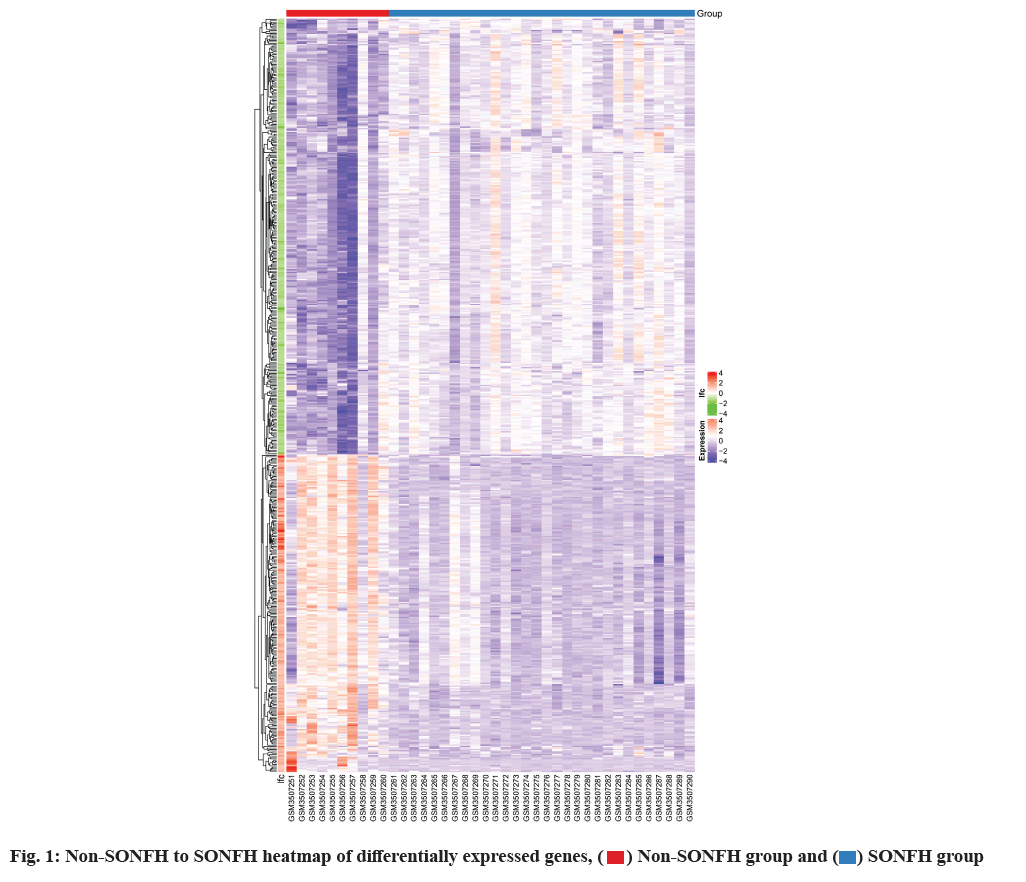
 ) Non-SONFH group and (
) Non-SONFH group and ( ) SONFH group
) SONFH group 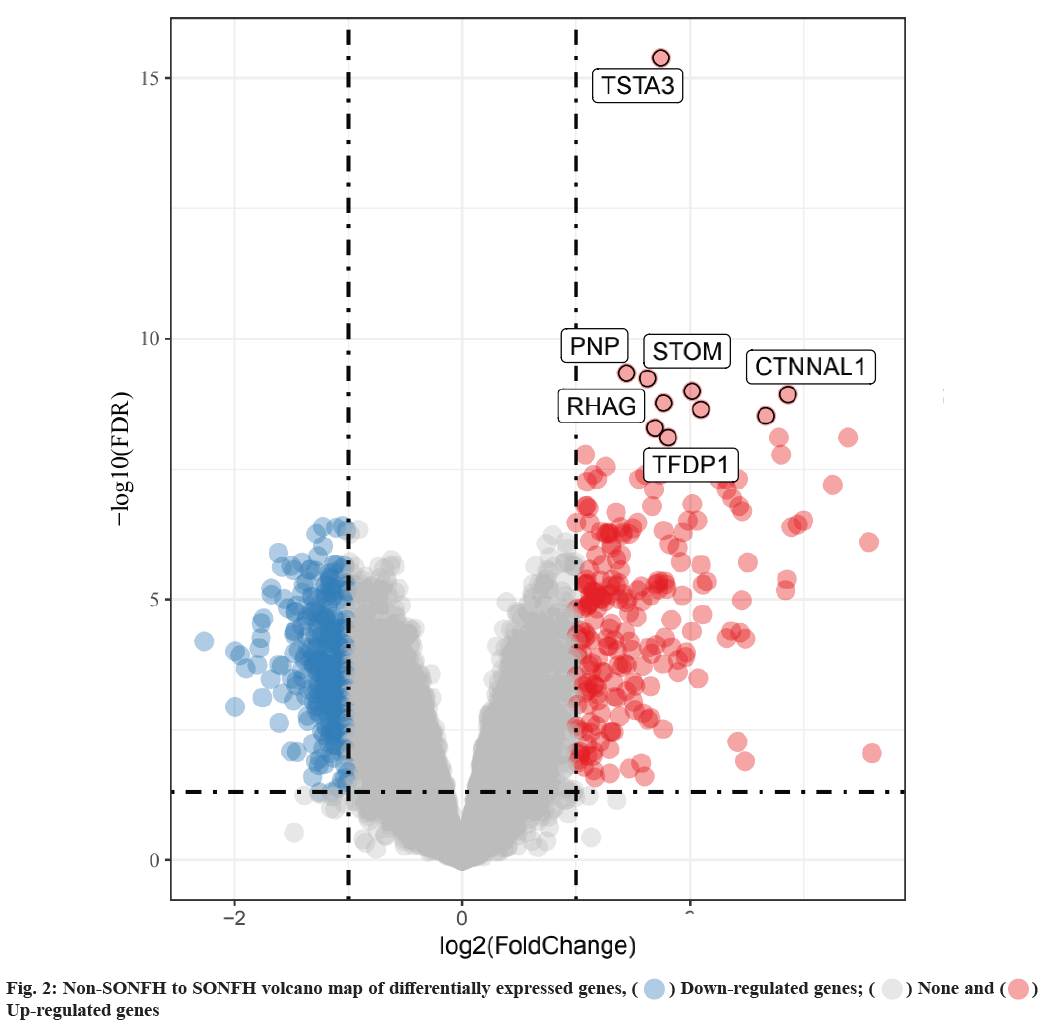
 ) Down-regulated genes; (
) Down-regulated genes; ( ) None and (
) None and ( )
Up-regulated genes
)
Up-regulated genes